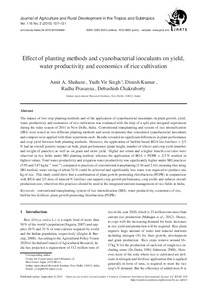Aufsatz

Effect of planting methods and cyanobacterial inoculants on yield, water productivity and economics of rice cultivation
Zusammenfassung
The impact of two crop planting methods and of the application of cyanobacterial inoculants on plant growth, yield, water productivity and economics of rice cultivation was evaluated with the help of a split plot designed experiment during the rainy season of 2011 in New Delhi, India. Conventional transplanting and system of rice intensification (SRI) were tested as two different planting methods and seven treatments that considered cyanobacterial inoculants and compost were applied with three repetitions each. Results revealed no significant differences in plant performance and crop yield between both planting methods. However, the application of biofilm based BGA bio-fertiliser + 2/3 N had an overall positive impact on both, plant performance (plant height, number of tillers) and crop yield (number and weight of panicles) as well as on grain and straw yield. Higher net return and a higher benefit-cost ratio were observed in rice fields under SRI planting method, whereas the application of BGA + PGPR + 2/3 N resulted in highest values. Total water productivity and irrigation water productivity was significantly higher under SRI practices (5.95 and 3.67 kg ha^(-1) mm^(-1)) compared to practices of conventional transplanting (3.36 and 2.44), meaning that using SRI method, water saving of about 34 % could be achieved and significantly less water was required to produce one kg of rice. This study could show that a combination of plant growth promoting rhizobacteria (PGPR) in conjunction with BGA and 2/3 dose of mineral N fertiliser can support crop growth performance, crop yields and reduces overall production cost, wherefore this practices should be used in the integrated nutrient management of rice fields in India.
Zitierform
In: Journal of Agriculture and Rural Development in the Tropics and Subtropics. Kassel : Kassel University Press. - Vol. 116, No. 2 (2015), S. 107-121Sammlung(en)
Vol 116, No 2 (2015) (Journal of Agriculture and Rural Development in the Tropics and Subtropics (JARTS))Zitieren
@article{urn:nbn:de:hebis:34-2015061048464,
author={Shahane, Amit A. and Singh, Yudh Vir and Kumar, Dinesh and Prasanna, Radha and Chakraborty, Debashish},
title={Effect of planting methods and cyanobacterial inoculants on yield, water productivity and economics of rice cultivation},
year={2015}
}
0500 Oax 0501 Text $btxt$2rdacontent 0502 Computermedien $bc$2rdacarrier 1100 2015$n2015 1500 1/eng 2050 ##0##urn:nbn:de:hebis:34-2015061048464 3000 Shahane, Amit A. 3010 Singh, Yudh Vir 3010 Kumar, Dinesh 3010 Prasanna, Radha 3010 Chakraborty, Debashish 4000 Effect of planting methods and cyanobacterial inoculants on yield, water productivity and economics of rice cultivation / Shahane, Amit A. 4030 4060 Online-Ressource 4085 ##0##=u http://nbn-resolving.de/urn:nbn:de:hebis:34-2015061048464=x R 4204 \$dAufsatz 4170 7136 ##0##urn:nbn:de:hebis:34-2015061048464
<resource xsi:schemaLocation="http://datacite.org/schema/kernel-2.2 http://schema.datacite.org/meta/kernel-2.2/metadata.xsd"> 2015-09-14T13:05:37Z 2015-09-14T13:05:37Z 2015-09-08 1612-9830 2363-6033 urn:nbn:de:hebis:34-2015061048464 http://hdl.handle.net/123456789/2015061048464 eng Kassel University Press Urheberrechtlich geschützt https://rightsstatements.org/page/InC/1.0/ conventional transplanting system of rice intensification (SRI) water productivity economics of rice biofilm bio-fertiliser plant growth promoting rhizobacteria (PGPR) 630 Effect of planting methods and cyanobacterial inoculants on yield, water productivity and economics of rice cultivation Aufsatz The impact of two crop planting methods and of the application of cyanobacterial inoculants on plant growth, yield, water productivity and economics of rice cultivation was evaluated with the help of a split plot designed experiment during the rainy season of 2011 in New Delhi, India. Conventional transplanting and system of rice intensification (SRI) were tested as two different planting methods and seven treatments that considered cyanobacterial inoculants and compost were applied with three repetitions each. Results revealed no significant differences in plant performance and crop yield between both planting methods. However, the application of biofilm based BGA bio-fertiliser + 2/3 N had an overall positive impact on both, plant performance (plant height, number of tillers) and crop yield (number and weight of panicles) as well as on grain and straw yield. Higher net return and a higher benefit-cost ratio were observed in rice fields under SRI planting method, whereas the application of BGA + PGPR + 2/3 N resulted in highest values. Total water productivity and irrigation water productivity was significantly higher under SRI practices (5.95 and 3.67 kg ha^(-1) mm^(-1)) compared to practices of conventional transplanting (3.36 and 2.44), meaning that using SRI method, water saving of about 34 % could be achieved and significantly less water was required to produce one kg of rice. This study could show that a combination of plant growth promoting rhizobacteria (PGPR) in conjunction with BGA and 2/3 dose of mineral N fertiliser can support crop growth performance, crop yields and reduces overall production cost, wherefore this practices should be used in the integrated nutrient management of rice fields in India. open access In: Journal of Agriculture and Rural Development in the Tropics and Subtropics. Kassel : Kassel University Press. - Vol. 116, No. 2 (2015), S. 107-121 Shahane, Amit A. Singh, Yudh Vir Kumar, Dinesh Prasanna, Radha Chakraborty, Debashish Gedruckte Ausg. im Verlag Kassel Univ. Press (www.upress.uni-kassel.de) erschienen. </resource>
Die folgenden Lizenzbestimmungen sind mit dieser Ressource verbunden:
Urheberrechtlich geschützt

